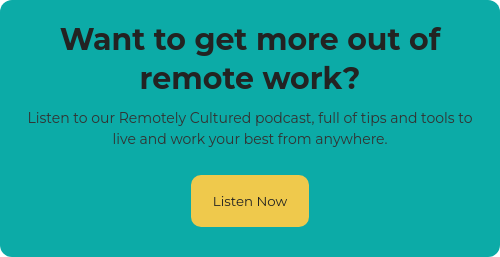Whether you're a remote worker from way back, or you joined the work-from-home crowd at the onset of the pandemic, you know (or are learning) how to walk the walk. But can you talk the talk?
Like most jobs, WFH life has its own lingo (case in point: WFH). And now that millions of Americans are looking to join or stay in remote work, we thought we'd share a glossary of the most important terms and phrases you need to know.
So, without further ado, here's all the jargon you'll need to sound like a #WFH or #WFA pro:
Remote Work Terminology
Asynchronous Communication
This includes any communication that doesn't happen in real time. It might be emails, DMs, comments on tasks, pre-recorded videos, or Slack messages. Async communication is especially helpful for remote teams scattered across multiple time zones.
Coworking/Coworking Space
Coworking is the name of a type of work that involves sharing office space with other professionals, and a coworking space is where it happens. Coworking spaces are a popular choice for many remote workers, as they offer numerous benefits like free Wi-Fi, lots of outlets, and a community of like-minded remote workers.
Digital Nomad
A digital nomad is a professional who prioritizes both work and travel. They typically plan long-term trips and work remotely from places around the world. They rely on technology, tools, and apps to remain productive and meet deadlines from wherever they are.
Distributed Teams
"Distributed teams" is basically another way to say "remote teams." Fully distributed companies (like First Page) are those that have embraced remote work and hire only employees who work from home or work from anywhere.
EOD/EOM/EOW
These acronyms are most often used to describe when reoccurring projects or reports are due, whether "end-of-day" (EOD), "end-of-week" (EOW), or "end-of-month" (EOM). This is useful for setting regular deadlines for repeating tasks or for letting remote colleagues know when they can expect to hear from you.
Expat
This stands for "expatriate" and refers to someone who lives outside of their home country. It's often to describe digital nomads who settle in another country.
Flex Time
This stands for "flexible time" and is a prevalent way to structure work-from-home schedules. When team members are working from different locations and time zones, flex time is essential. It ensures that people can get their work done when and where it works for them.
Freelancer
Freelancers work for themselves and often take one-off projects or independent contracts with larger companies and set their own rates. Sometimes they're referred to as self-employed workers or 1099 workers, alluding to the tax form they get at tax time. They may choose to work from home or work as a digital nomad.
Hotdesking
Hotdesking is a fad in modern office settings where employees frequently have no permanent desk and frequently change spots. In remote work, hotdesking means desk or office hopping by changing up where one works, whether it's frequenting coffee shops or libraries or looking for short-term private office spaces.
Independent Contractor
Similar to freelancers, independent contractors work for themselves, but they may take on longer-term projects with established companies and integrate as part of an established team. They have more freedom, flexibility, and stability, though they do not receive the same benefits as full-time employees.
Location-Independent
This describes someone who can work from anywhere; most frequently, it relates to digital nomads and those who travel while they work.
Ping
Mostly used as a verb, you may hear a remote worker say, "Ping me." It typically means sending an instant message on the platform used by your employer. Usually, when someone asks you to ping them, it's because they want a heads-up on something in a timely manner.
Project Management Platform
This is where the magic happens. Most project management platforms, like ClickUp, Asana, Trello, or Basecamp, offer boards, lists, or tiles where projects are managed from start to finish. Tasks and subtasks are assigned to employees, workflows and processes are implemented, and progress and hours are tracked to ensure nothing falls through the cracks.
Remote-First
A remote-first company is generally fully distributed and has an entire team comprised of remote workers. Most of the time, workers are not in the same location and may work from multiple countries and time zones. Some companies can also be considered remote-friendly (open to hiring remote employees and/or offering hybrid work options) or remote-curious (exploring the possibility of bringing on remote employees).
Remote Onboarding
This is the process a remote or distributed company uses to bring on new employees. Remote onboarding may be similar to traditional onboarding in the information it provides but very different in that every step happens digitally and off-site.
Remote Workers
Any professional who does not work in a traditional office setting is a remote worker. Remote workers include digital nomads and those who work from home.
Retreat
Retreats are an occasion when remote employees travel to the same location to connect in person, most often for team-building purposes. Retreats may be more focused on culture and relaxation or on brainstorming and working.
Single Source of Truth
This is critical for remote teams. It refers to the way information is shared digitally and indicates where workers can go to find the information they need. Often, SSoTs are located within a project management platform, a wiki, or a resource hub so the people who need it can easily access it.
Stand-Up
No, you don't actually have to stand up. This type of meeting is typically held once a day or once a week and is usually a quick check-in so remote workers can share what they're doing, request support, or share any blockers.
Synchronous Communication
The opposite of async communication, this refers to any type of communication that occurs in real time. Phone calls, video meetings, and sometimes chat are all included in synchronous communication. For remote teams, both sync and async communication are critical to managing productivity, workflow, and outcomes.
Video Chat
Video services have become a must-have for remote teams. It can facilitate synchronous communications (e.g., on Zoom) or asynchronous communications (e.g., a pre-recorded video on Loom). It can also be good for a laugh, as many of us learned through various Zoom snafus over the last couple of years.
Virtual Office
Though it sometimes refers to a product or service that provides the tools needed for remote companies to work together, "virtual office" can also refer to the space in which a remote team's work happens — even if it happens across multiple platforms.
WFH
This stands for "work from home" and describes remote employees who conduct most of their business from their home or in their local community (e.g., local businesses, coworking spaces, etc.).
WFA
This stands for "work from anywhere" and describes remote professionals who work from home and other locations. That might include their garden or pool or far-flung locations in other countries around the world. Digital nomads embrace the WFA life, whether they travel the globe or stay domestic, exploring their home country.
Work-Life Balance
It's the reason most people pursue remote work in the first place. Remote workers may work outside of normal business hours, but they tend to be happier, more fulfilled, and feel that their work and personal lives are in-tune.
So, the next time you hear these words and phrases, you'll be in the know (and hopefully living your best WFH life).







